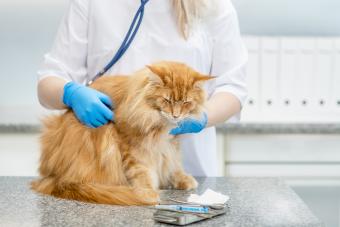
Mating cats for the first time takes knowledge, patience, and some trouble-shooting. Sometimes a male or female cat will refuse to mate, and unfortunately, no matter how much you want a pair of cats to mate, if either refuses, you cannot make them mate. This can create problems, especially if the underlying cause is a medical issue that requires treatment. However, you can become a better breeder by understanding why this is happening and use our six tips for a first time cat mating.
First Time Mating
If a female cat is new to the mating process, she may be anxious and stressed by having the male come near her. This can be exacerbated if other factors in the environment increase the stress, such as being taken to mate some place other than her familiar home, disruptive noises or scents, or too much activity and people in the area.
You can use these six tips to make first time mating run smoothly:
- Reduce any possible stressors in the environment.
- Do the mating in the female cat's home where she's comfortable.
- Use a male that is experienced.
- Allow her to spend time with the male when not in heat, so she becomes used to his presence. Make sure she has room to retreat to get away from him and make the introductions slowly, as you would with any cat.
- If you can't have her spend time with the male (as in situations where the male lives with another breeder), you can ask the breeder for a blanket or bed with his scent on it and allow her to get used to it for a few days at least before the mating.
- Consider using UV light to facilitate breeding (this is believed to help induce breeding behavior).
Using UV Light to Encourage Breeding
There are different phases in the cat's cycle and in the winter, when the days are typically shorter, the cats will be in the anestrus phase. This is the inactive stage between cycles, where the female is not prepared to breed. The males will also not be interested in mating during this time.
Artificial UV lights can "fool" the cat's body into thinking it is a different season. It is typically recommended that you create either 12 hours of light and 12 hours of dark or 14 hours of light and 10 hours of dark; whichever works best for your cats. Keep in mind this may not work with every cat!
It is true that lights have been used to induce heat in the females, as felines are polyestrous. Polyestrous means that they can come into heat multiple times throughout the year.
Why a Female Cat Refuses to Breed
In some cases, the female cat will refuse to allow a male to mate with her. If the male attempts to get close to her, she will fight him fiercely until he goes away. There are a few reasons this can happen.
1. She Is Not Ready for Mating
Some females may simply not be ready to mate, even if they go into heat. This can happen with a female brand new to going into heat and mating, or even with experienced females. According to small animal veterinarian Sara Ochoa, DVM, it's possible that, "The cat does not like the male cat. Cats can be very picky, and, if they do not like their mate, they will not allow them to breed with them."
It's also possible she may not be feeling well that day, either for temporary reasons such as an upset stomach, or from an underlying medical condition. Never force a cat to mate in these situations and seek out your veterinarian if you suspect she might be ill.
2. She's Not in Heat
Says Dr. Ochoa, "If a cat is not in heat, they will refuse to mate." Some cats may seem like they are in heat but are not. If you're new to dealing with breeding cats, consult with your veterinarian, as it's possible you've misread the signs and your cat is not yet in heat.
3. She's Pregnant
Another reason a female may refuse to mate is if she's already pregnant. A cat that is already pregnant, "Will refuse the male cat." If you suspect she may be pregnant, have her checked out with your veterinarian to be sure.
Why a Male Cat Refuses to Breed
With male cats, there are a few possible reasons why they may be reluctant to breed with a female. Just as with females, you ultimately cannot force a male cat to breed, but it's good to know why he is refusing, especially if it's due to medical issues that require veterinary intervention.
1. He Lacks Experience
A male cat, or tom, may not be willing to mate with a female in heat because he has not mated before and may be intimidated or stressed by approaching the female. Pairing him with a more experienced female may increase the chances that a successful mating will occur.
2. He Lacks Maturity
Certain breeds of cats take longer to reach maturity than others. In these cases, a tom may seem young enough to breed compared to the "average" cat, but may not be physically and socially ready. Examples of breeds that take longer to mature include the American Shorthair, Manx, Persian, and Ragdoll.

3. He Is Neutered
If you took in your cat as an adult and are not sure if he is fixed or not, look to see if he has visible testicles in his groin area. If he does not, he is most likely neutered, and is therefore unable to breed. Your veterinarian can check him for you and tell you if he's been sterilized or not.
4. He Has No Interest in the Female
Just as female cats can dislike a male for their own reasons, a male cat can be uninterested in a particular female. A male cat may also have no interest in a female that he has a previous bad relationship with, such as a female in the household who bullies him, or who has initiated fights with him prior to going into heat.
5. It's Cold Out
In the cold months of winter, some males are totally uninterested in breeding, even with an available female in heat. This is partially what leads some to believe that keeping a natural UV light on where the cats spend most of their time will encourage him to breed.
6. He Has a Medical Condition
A male cat, like a human male, can have issues with a lack of testosterone, which can have a negative effect on their desire to mate. Other medical conditions that might deter him from wanting to mate could be physical injuries, dental disease, or obesity. If you suspect your male cat has an underlying medical problem, have him checked out by your veterinarian right away.
How to Mate Cats
Experienced breeders will know that male and female cats can refuse to breed for a variety of breeds. These can include lack of experience, immaturity, medical problems, and simply not liking the other cat. If you're new to breeding, it's best to work with an experienced breeder who can mentor you on best practices to keep your cats and their offspring healthy and happy.







